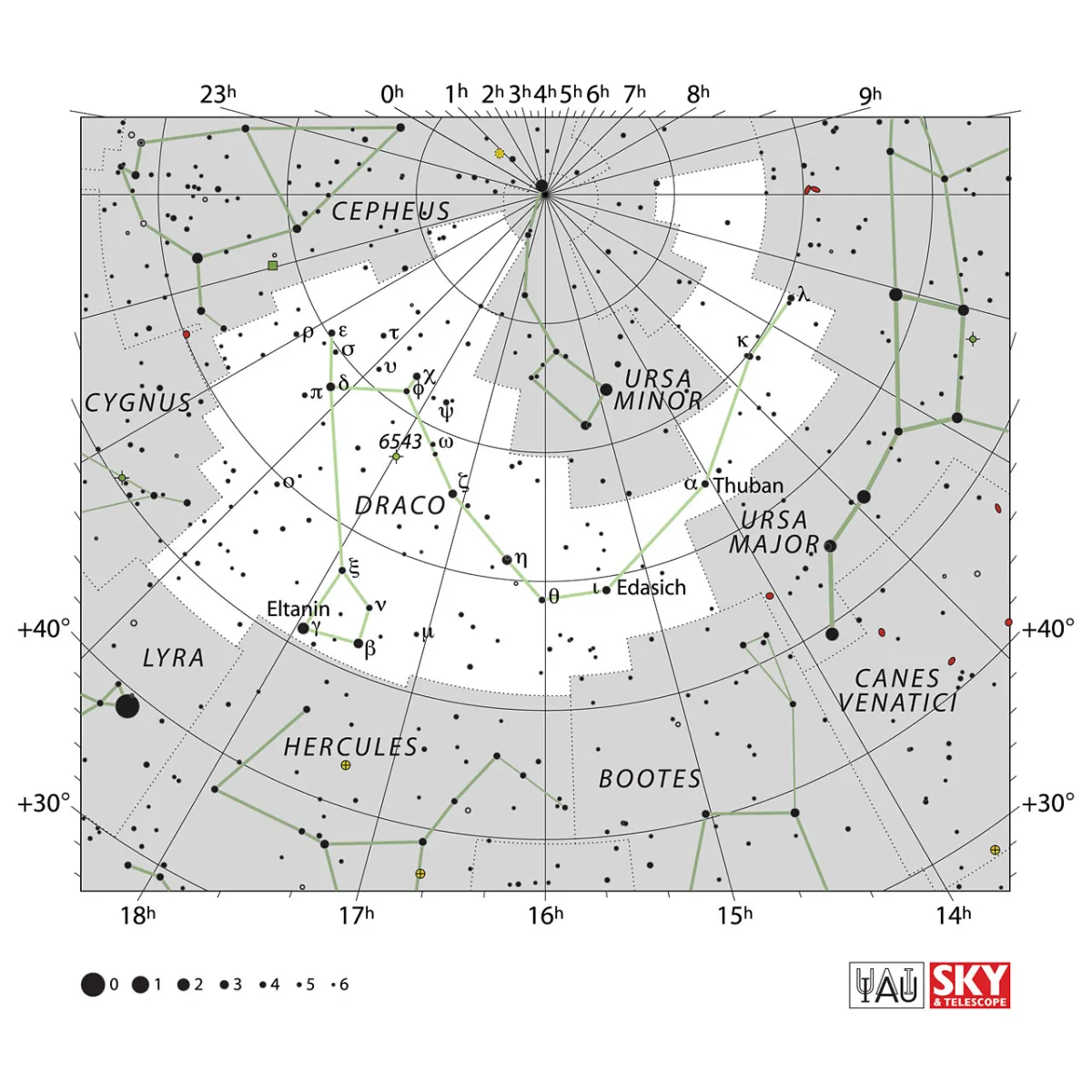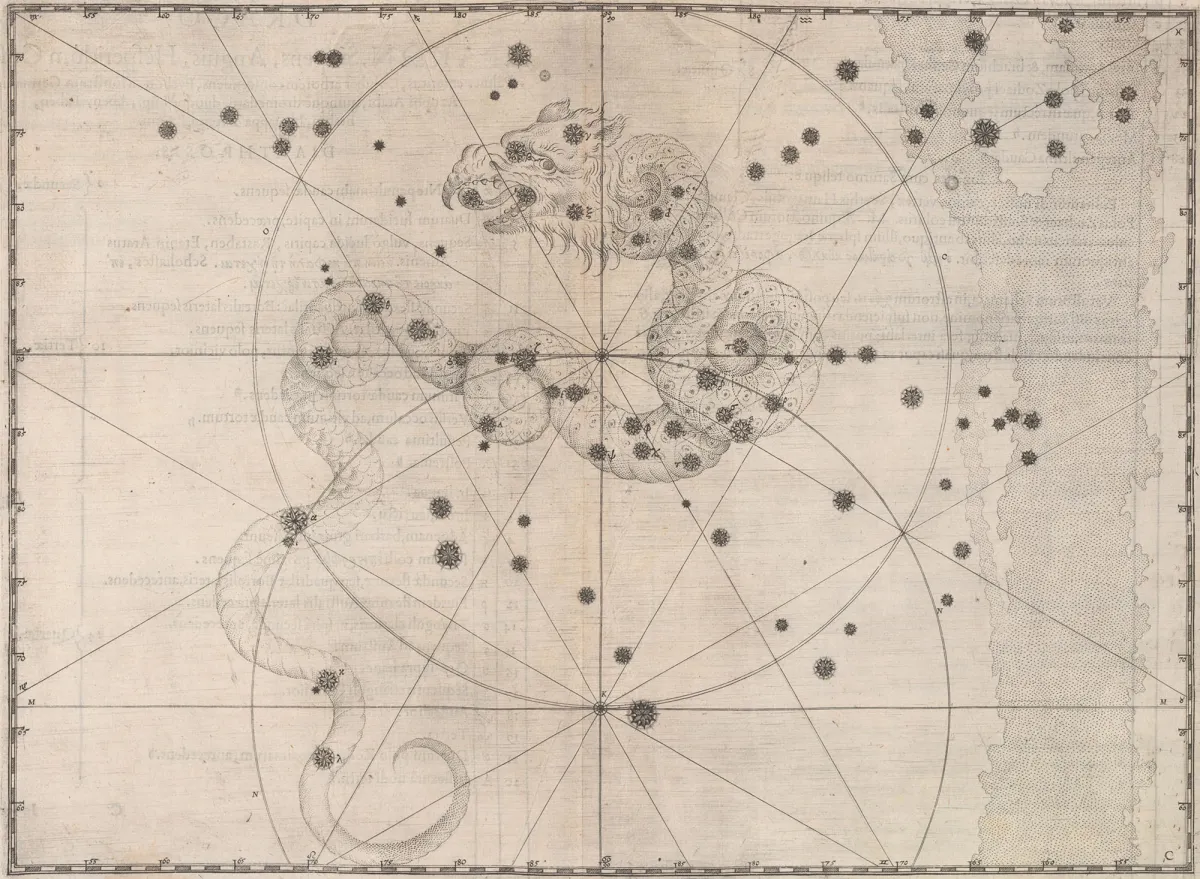Constellation Draco (Dragon)

Properties
With 1083 square degrees, Draco is a large, albeit complex, constellation in terms of area. It extends from the area Cygnus / Lyra to Ursa Maior and wraps around Ursa Minor. The dragon's head looks down on Hercules further south. The centre of the constellation culminates around midnight on May 24th.
Near the galaxy NGC 6554 and the Cat's Eye Nebula NGC 6543 lies the north pole of the ecliptic, which the celestial north pole orbits at an angular distance of 23 ° 27 'over the course of 25,700 years. This movement is caused by the precession of the earth's axis. [9, 15]
| α Dra | Thuban, Adib, Dragon's Tail |
| β Dra | Rastaban, Alwaid, Asuia, Rastaben |
| γ Dra | Etamin, Etanin, Ettanin, Rastaban, Rasaben, Zenith Star |
| δ Dra | Nodus Secundus, Altais, Aldib |
| ε Dra | Tyl |
| ζ Dra | Aldhibah, Eldsib |
| ι Dra | Ed Asich, Eldsich, Al Dhiba, Al Dhihi |
| λ Dra | Gianfar, Giansar, Gaiusar, Giauzar, Juza |
| μ Dra | Arrakis, Errakis, Al Rakis, El Rakis |
| ν2 Dra | Kuma |
| ξ Dra | Grumium, Genam, Nodus I |
| σ Dra | Alsafi, Athafi |
| ψ1 Dra | Dsiban, Dziban |
| IAU Name | Draco |
| IAU Genitive | Draconis |
| IAU Abbr. | Dra |
| English Name | Dragon |
| Culmination at local midnight | 18 June |
| Season (Latitude +0.0°) | February … November |
| Right Ascension (J2000.0) | 09h 22m 28s … 20h 54m 49s |
| Declination (J2000.0) | +47° 32' 51" … +86° 27' 56" |
| Area | 1083 deg2 |
| Neighbours (N↻) | UMi, Cam, UMa, Boo, Her, Lyr, Cyg, Cep |
Deep-Sky Object Descriptions
Catalogues

Mythology and History
Dragons appear in many old legends and fairy tales, so it is hardly surprising to find such a creature in the sky. Perhaps it is the dragon that Hercules had to defeat in order to get the golden apples of the Hesperides so that he could bring them to Eurysteus. These apples were special: for those who ate them attained eternal youth. This precious apple tree grew in the west, on the edge of the earth. He was guarded by the giant Atlas, the bearer of the heavens, his daughters, the Hesperides and a terrible dragon. The dragon had a hundred heads, many different voices, and never slept.
Today's image of the kite in the sky makes a rather harmless impression. This is probably due to the fact that Thales von Miletus had removed the wings of the dragon image around the year 500 BC and formed a new constellation from it: the Little Bear (Ursa Minor).
The Greek name Drakon was used for this constellation, but also the Latin expressions Anguis, Coluber, Python and Serpens, which all meant something like snake or dragon. The name Custos Hesperidum is reminiscent of the guarding of the tree with the golden apples of the Hesperides. On the occasion of the Christianization of the starry sky, however, the dragon withered into the old serpent that seduced Eve to the fall of man in Paradise. In Persia this constellation was called Azhdeha and it was seen as a man-eating snake. Babylonian documents speak of a snail, a constellation that is said to be near the pole star; the snail-like twisting figure of the dragon is reminiscent of this Babylonian point of view. In early Egypt this constellation was interpreted a little differently, people spoke of the hippopotamus or hippopotamus or understood it to be a crocodile. Arab astronomers have translated the word Drakon as Al Tinnin and as Al Thuban. [7, 20]